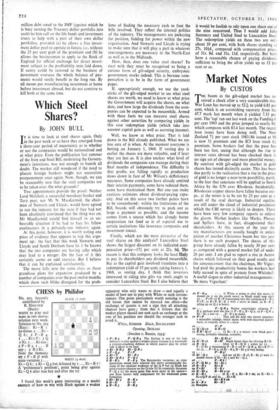Which Steel Shares?
By JOHN BULL
IT is time to look at steel shares again. Only in the past week or so have they emerged from a three-year period of uncertainty as to whether or not the companies would be nationalised and at what price. Even the publication last summer of the Iron and Steel Bill, enshrining the Govern- ment's intentions, was not enough to banish all doubt. The market still wondered if the need to placate foreign bankers might not necessitate postponement once again. Now, though, we can be reasonably sure that the steel companies are to be taken over. On what grounds?
Two appointments provide the proof. Neither Lord Melchett, a successful merchant banker and Tory peer, nor Mr N. Macdiarmid, the chair- man of Stewarts and Lloyds, would have agreed to run the industry for the state if they had not been absolutely convinced that the thing was on. Mr Macdiarmid would find himself in an un- bearable situation if he had to face his fellow steelmasters in a privately-run industry again.
At this point, however, it is worth noting one piece of evidence that appears to trip this argu- ment up: the fact that this week Stewarts and Lloyds and South Durham have let it be known that the two companies are having talks which may lead to a merger. On the face of it this certainly seems an odd exercise. But I believe that it can be explained satisfactorily.
The move falls into the same class as those grandiose plans for expansion produced by a number of companies over the past twelve months which show such blithe disregard for the prob- lems of finding the necessary cash to foot the bills involved. They reflect the internal politics of the industry. The managements are jockeying for position, bidding for power within the new organisation. And Stewarts and Lloyds is trying to make sure that it will play a part in whatever rearrangements are necessary in the North-East as well as in the Midlands.
How, then, does one value steel shares? To start with they must be recognised as being a curious form of gilt-edged security, embryonic government stocks indeed. This is because com- pensation is to be in the form of government paper.
If, appropriately enough, we use the yard- sticks of the gilt-edged market to see what steel shares are worth, we need to know at what price the Government will acquire the shares, on what date, and how large the dividends from the com- panies can be expected to be meanwhile. Armed with these facts we can measure steel shares against other securities by comparing yields, in this case redemption yields (which take into account capital gain as well as accruing income).
Well, we know at what price. That is laid down in the Bill already published. What we are less sure of is when. At the moment everyone is betting on January 1, 1968. If vesting day is earlier the shares are more valuable, and if later they are less so. It is also unclear what level of dividends the companies can manage during their final months of independence. The difficulty is that profits- are falling rapidly as production slows down in face of Mr Wilson's deflationary measures. Some companies have already omitted their interim payments, some have reduced them, some have maintained them. But one can make cautious estimates about dividend-paying capa- city. And on this score two further points have to be remembered: within the limitations of the Bill, boards will obviously- try to push out as large a payment as possible; and the income comes from a source which has already borne corporation tax (and so is of especial use to certain institutions like insurance companies and investment trusts).
Finally, which are the most attractive of the steel shares on this analysis? Lancashire Steel shows the largest discount on its indicated com- pensation price-17+ per cent at 21s. 9d. The reason is that this company looks the least likely to pay its shareholders any dividend meanwhile. But as the capital gain involved translates into a redemption yield of 15 per cent, taking January 1, 1968, as vesting day, I think that investors interested in riding into gilts via steels ought to consider Lancashire Steel. But I also believe that it would be foolish to rely upon one share out of the nine concerned. Thus I would add John Summers and United Steel to Lancashire Steel. The redemption yields on these two are only about 10 per cent, with both shares standing at 27s. 104d., compared with compensation prices of 31s. 8d. and 31s. lid. respectively. But both have a reasonable chance of paying dividends sufficient to bring the all-in yields up to 15 per cent or so.


































 Previous page
Previous page